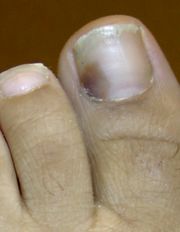Subungual hematoma: Difference between revisions
No edit summary |
No edit summary |
||
| Line 2: | Line 2: | ||
A '''subungual hematoma'''<ref name="isbn0-7817-5074-1">{{cite book |author=Henretig, Fred M.; Fleisher, Gary R.; Ludwig, Stephen |title=Textbook of pediatric emergency medicine |publisher=Lippincott Williams & Wilkins |location=Hagerstwon, MD |year=2006 |pages= |isbn=0-7817-5074-1 |oclc= |doi= |accessdate=}}</ref> is a collection of [[blood]] ([[hematoma]]) underneath a [[Nail (anatomy)|toenail]] or fingernail which often results from a traumatic injury such as slamming a [[finger]] in a door. A [[wound|laceration]] of the [[nail bed]] causes bleeding into the constricted area underneath the hard nail plate. Because the blood disrupts the connections between the nail bed and nail plate, throbbing pain is common. The nail develops a black discoloration overlying the laceration. | A '''subungual hematoma'''<ref name="isbn0-7817-5074-1">{{cite book |author=Henretig, Fred M.; Fleisher, Gary R.; Ludwig, Stephen |title=Textbook of pediatric emergency medicine |publisher=Lippincott Williams & Wilkins |location=Hagerstwon, MD |year=2006 |pages= |isbn=0-7817-5074-1 |oclc= |doi= |accessdate=}}</ref> is a collection of [[blood]] ([[hematoma]]) underneath a [[Nail (anatomy)|toenail]] or fingernail which often results from a traumatic injury such as slamming a [[finger]] in a door. A [[wound|laceration]] of the [[nail bed]] causes bleeding into the constricted area underneath the hard nail plate. Because the blood disrupts the connections between the nail bed and nail plate, throbbing pain is common. The nail develops a black discoloration overlying the laceration. | ||
Subungual hematomas are treated by either releasing the pressure by drilling a hole through the nail into the hematoma ([[Trepanation|trephining]]) or by removing the entire nail. Trephining is generally accomplished by using a heated instrument to pass through the nail into the blood clot. Removal of the nail is typically done when the nail itself is disrupted, a large laceration requiring [[suture|suturing]] is suspected, or there is a [[Fracture (bone)|fracture]] of the tip of the finger. Although [[Anesthesia|anesthesia]] is generally not required, a [[digital nerve block]] may be performed if the nail is to be removed. Subungual hematomas typically heal without incident, though [[infection]] or disruption of the nail ([[onycholysis]]) may occur. | Subungual hematomas are treated by either releasing the pressure by drilling a hole through the nail into the hematoma ([[Trepanation|trephining]]) or by removing the entire nail. Trephining is generally accomplished by using a heated instrument to pass through the nail into the blood clot. It should be noted that a heated instrument is not used on acrylic nails because they are flammable. Removal of the nail is typically done when the nail itself is disrupted, a large laceration requiring [[suture|suturing]] is suspected, or there is a [[Fracture (bone)|fracture]] of the tip of the finger. Although [[Anesthesia|anesthesia]] is generally not required, a [[digital nerve block]] may be performed if the nail is to be removed. Subungual hematomas typically heal without incident, though [[infection]] or disruption of the nail ([[onycholysis]]) may occur. | ||
== References == | == References == | ||
{{Reflist|2}} | {{Reflist|2}} | ||
[[Category:Nail diseases]] | [[Category:Nail diseases]] | ||
Revision as of 16:28, 31 July 2012

A subungual hematoma[1] is a collection of blood (hematoma) underneath a toenail or fingernail which often results from a traumatic injury such as slamming a finger in a door. A laceration of the nail bed causes bleeding into the constricted area underneath the hard nail plate. Because the blood disrupts the connections between the nail bed and nail plate, throbbing pain is common. The nail develops a black discoloration overlying the laceration.
Subungual hematomas are treated by either releasing the pressure by drilling a hole through the nail into the hematoma (trephining) or by removing the entire nail. Trephining is generally accomplished by using a heated instrument to pass through the nail into the blood clot. It should be noted that a heated instrument is not used on acrylic nails because they are flammable. Removal of the nail is typically done when the nail itself is disrupted, a large laceration requiring suturing is suspected, or there is a fracture of the tip of the finger. Although anesthesia is generally not required, a digital nerve block may be performed if the nail is to be removed. Subungual hematomas typically heal without incident, though infection or disruption of the nail (onycholysis) may occur.
References
- ↑ Henretig, Fred M.; Fleisher, Gary R.; Ludwig, Stephen (2006). Textbook of pediatric emergency medicine. Hagerstwon, MD: Lippincott Williams & Wilkins. ISBN 0-7817-5074-1.